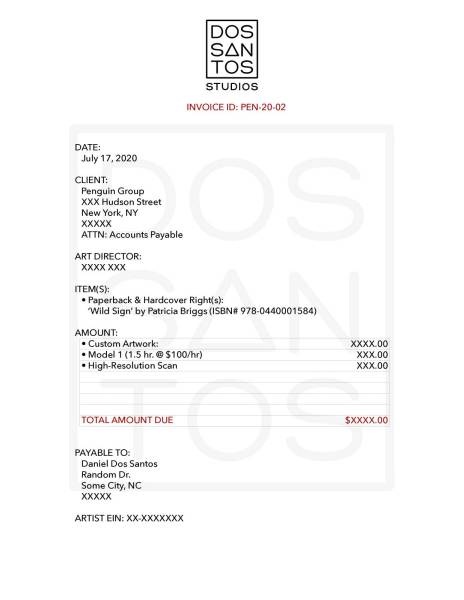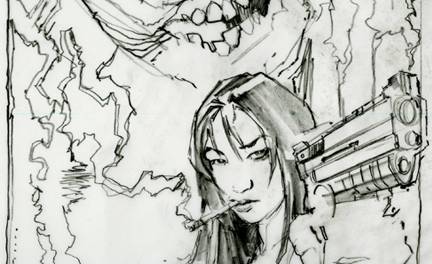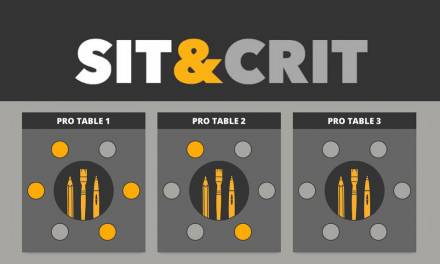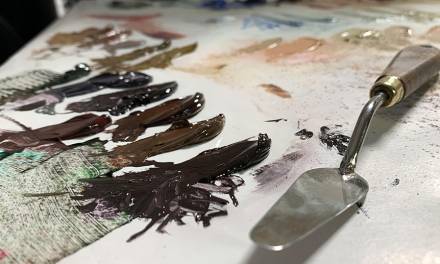The most important part of any commission is undoubtedly the invoice. Yet, the topic seems to be overlooked in most art educations. After you’ve received a commission, done the sketches, and painted your heart out… you need to bill the client.
If you do not send an invoice, you will not get paid!
I have learned this the hard way. I once handed in a job while I was suffering from a nasty stomach flu. I feel like I barely survived the ordeal, and after the job was completed I slept for days. As a result of the illness, I totally forgot to send the invoice. Since I didn’t send a bill, the client never sent a check, and it went unnoticed for over a year! Eventually it came time to do my taxes and I noticed the discrepancy. I contacted the AD, and she fortunately was able to confirm that Accounting had indeed never received a bill, and the matter was quickly solved. But had I never noticed, I would have done all of that work for free, and been out of several thousand dollars.
I usually send the invoice about one or two weeks after completing the commission. I do not send it immediately because if there are late revisions on the painting, I would have to revise the invoice as well, and now Accounting has two different copies to deal with. I was also taught by my Mentor that it is simply more tactful to wait a few days.
So what should an invoice look like? The short answer is, pretty much anything… so long as it gets the job done. Attached below is a copy of what my typical invoice looks like. I believe that this format contains all the pertinent information that a good invoice should have, and can serve as a decent template for your own.
Many large clients nowadays will have have a very specific guideline for creating and submitting invoices. If they do, follow their guidelines! But if not, this one should meet most client’s needs.
A little bit about some of the reasoning behind it:
Artist Invoice ID #:
Often times a client will provide you with a Purchase Order number. You need to include this in your invoice if they give you one. However, regardless of having a PO number, I still include my own invoice number as well. When you receive payment from the client, the check will not describe what painting it is they are remitting payment for, or give it’s title… it will only note the invoice number. If you are doing multiple jobs for the same client over a period of months, it quickly gets confusing as to whether or not you’ve been paid for a particular job. I work for 3 or 4 different imprints all under the name of Penguin, so it’s important I be able to keep track of any outstanding balances. By having my own invoice number, I know exactly what painting the check is for when I get it.
Typically, I use the first few letters of the book’s title, followed by a numeral. The numeral either denotes a date, or how many times I have sent the bill. If the bill is unpaid after 90 days, I will send a second copy called XXXXX-02.
Client:
Just like a contract, all bills should include who is being billed, and whom they are being billed by.
Art Director/Buyer:
Often times Accounting will need to confirm an expense listed on an invoice. If they need to do that, this makes it easy for them to contact the Art Buyer in charge of the project to confirm costs. It’s also just a good habit to list who is purchasing the art (see point above).
Item(s):
It seems obvious, but be sure to let the client know what it is you are charging them for. This part is especially helpful when selling secondary rights to an image, as you can make note of it here. I just change the words ‘Full-color Illustration’ to ‘Secondary Rights’. That way, the client is acknowledging the rights restrictions before they send payment. In essence, it serves as confirmation of an agreement.
Amount:
Many Publishers will provide a small expense budget for models, props and the like, especially if you’ve been illustrating a long time like me. It is important to itemize these expenses so that the client knows exactly what they are being charged for. I sometimes attach a scan of the receipts if there is a particularly unusual expense.
Artist EIN#:
Most Publishers now have a vendor application that an Artist needs to fill out before working with them. This application will have your SS# or EIN on it for tax purposes. However, this is not always the case, and so I usually include it directly on the invoice for trusted clients. Using an EIN is preferred since it can’t be used for identify theft. You can get an EIN for business almost instantaneous right here: https://irs-gov-ein-number.com/
Payable To:
Again, it seems obvious, but if you don’t give them a mailing address or a bank account, the client won’t know where to send your money.
Format:
Lastly, most clients now accept invoices through email. If you choose to do this, remember to save your file as a PDF or DOC file. Even though the Art Director can easily view/print JPEGS, the Accounting Department may not. So be sure to use a format that caters to typical office personnel.
The goal of an invoice like this is to keep things easy and efficient. If the AD has to email you a million times asking for more information, you are simply delaying the payment process. By streamlining your invoice, you not only make the AD’s job easier, but you are ensuring a smooth and prompt payment.








Awesome post!!
This part of the work process is so important as learn how to draw.
Artist needs to have that business side otherwise they will pass their whole life working for free.
Thanks for sharing that information.
Cheers,
Rod.
Did i mention how much i love you guys?
Great advice dan, and you're totally right, art institutions really do look over these sorts of details.
That's a great post. U-Art's illustration program did spend some time helping its students develope invoices, but it's always good to have a refresher. I really like the idea of using the job name as a point reference- I'll to take that wisdom with me; it kicks the pants out of my strictly number based invoicing system. Thanks for the post Dan!
I was about to mention UArts's illustration program actually touched base on this, however i feel it's something that every professional artist should be aware of regardless. Plus it always helps to see actual examples and it's nice to have the page broken down and explained like you've done in this post. Thanks for sharing your input, man!
In this circumstance, would you send this before the artwork itself?
Very helpful!
Just a quick note emphasizing the bit about including a social security (or business tax i.d.) number on your invoices. I can't count the number of times Andrews McMeel's accounting department has called up wanting a freelancer's SS#—and they'll sit on the check until they get it. So if the purchase order doesn't request it, you can include it on your invoice or, if you're not comfortable sending it through the mail, call your client and offer it over the phone. One way or the other, they'll need it for the 1099 come tax season…
Very helpful! I'm still trying to come to grips with the business side of this stuff; getting pointers from established artists like yourself is a huge help.
Great info! Now I just wish I worked for publishers who could afford to pay an artist well, much less enough so the artist could afford paid models.
i feel like art schools not only overlook the “minor” detail, but sometimes seem to try really hard to keep it from coming up, at least in the field of painters. the whole business-of seems to be never talked about, and this is especially informative for somebody looking into illustration as a career choice. thank you for posting this.
I didn't know that publishers would sometimes pay the model fee. That sure makes the thought hiring models less daunting. Great post!
In some countries it's even obliged by law to have things like a unique invoice nr, the date and a description of the delivered services/goods mentioned on the invoice.
I strongly advise everyone to keep a backup of your digital invoices and other business related documents on a separate location.
You never want your studio/home to burn down or broken into and your pc gets stolen, but when it does happen, you're glad you made the efforts of backing up!
Very informative. Could you, at some future post, also explain how an artist decides how much to charge a client for their artwork? Do you charge by the hour or by some other method? Also, regarding selling the rights to artwork what criteria to you follow in that decision process? Are there resources available to someone new to all of this?
Thanks again for a great post!
Marty
great post Dan, thanks! My invoice looks fairly similar which makes me feel better about it because I am totally making everything up as I go…
Do you recommend tracking invoices with a program like Quickbooks, which also simplifies tax submissions, or do you go the spreadsheet route? Both are a bit clunky but they have their benefits. I use paper copies and emails, filing them in my cabinet, which has benefits but is equally clumsy. At least my filing cabinet doesn't crash! (Well, I guess I could push it over… 🙂
Thanks for the post.
Oh, awesome and useful. Maybe you can also answer another question I've had recently: If I work on a cover commission, who retains the copyright to the artwork? I'd like to be able to sell secondary rights and publish in Spectrum and the like, but if I'm working from an author's precis (no art director, just me and the author), do they retain rights?
This post was so helpful, I reposted it on my blog and have just referred to it! 🙂
What about how long to leave an invoice for before taking action again? You mentioned 90 days. Should I mention 90 days somewhere in the invoice to make it clear? Also, I am British, but my client is American. I don't have a SS#, so will they still need something like that from me or does it not matter?
I have tried many billing apps. I used these for sometime, but have recently switched to http://www.billin.in/ . It is a good resource. Very intuitive and robust application.
I have received a photo budget for my books but all other projects it really never crossed my mind to charge for scans, as we do it in-house. BUT it does take time to do, especially with the bigger, more structurally complex works. Is there a flat fee you charge for this? Thanks for opening my eyes to this!
Great advice! I couldn’t agree more about the importance of sending an invoice promptly. I’ve also found that including a payment due date helps to keep things organized. Thanks for sharing your invoice template – it’s definitely helpful for freelancers like me! 💼💰